

In “Vanishing Ice” — an ambitious new exhibit at Bellingham’s Whatcom Museum — art, science, climate- change concerns and the history of exploration all meet in a splendidly orchestrated passage. On show through March 16.
Art exhibit? History of exploration? Environmental awareness-raising session?
“Vanishing Ice: Alpine and Polar Landscapes in Art, 1775-2012” is all those things and more.
It’s both an impressive new exhibit at Bellingham’s Whatcom Museum, and an even more impressive book by the museum’s curator of art, Barbara C. Matilsky (Whatcom Museum/University of Washington Press, 144 pp., $39.95). Encompassing painting, photography, video and book publications, it tells the story of explorers, scientists and artists drawn to icebound environments.
“Story” is the key word here, and in order to tell it fully Matilsky has taken the unorthodox approach of including high-quality reproductions of artworks the museum wasn’t able to borrow, interspersing them with archival photographs and magnificent original oils-on-canvas by Rockwell Kent, Albert Bierstadt, Thomas Hart Benton, Lawren Harris (of Canada’s famed Group of Seven) and others.
The contemporary artists’ works — grand in scale and ambition — are, of course, all original. They were also pivotal in triggering the exhibit.
As Matilsky explains in the exhibit catalog, her doctoral dissertation was on late 18th- and early 19th-century French landscape artists who were among the first to portray alpine and polar-sea scenes.
“I could never have imagined,” Matilsky writes, “that these artists would later provide insight into the scientifically significant alpine and polar regions currently threatened by a changing climate.”
The idea for a centuries-long survey of ice in art came to Matilsky around 2005, when she grew aware of the increasing number of contemporary painters, photographers and videographers journeying to polar regions and glaciated mountainscapes, seeking inspiration.
“I began thinking about the similarities and differences among generations of artists who were drawn to icy climes,” she writes. “While examining these parallels, a cultural perspective crystallized that I believed could spotlight climate change in a new way.”
The result is a show that’s exquisitely balanced between keen aesthetic pleasures and sobering scientific perspective.
Pleasures first: Harris’ “Isolation Peak, Rocky Mountains” (1930), Kent’s “Resurrection Bay, Alaska” (c. 1939) and Benton’s “Trail Riders” (1964-65) are truly magnificent modernist distillations of their chosen landscapes. Harris’ “Peak” is an especially luminous stylization of icy, precipitous grandeur.
Nineteenth- and 20th-century photographers are well represented too, with the Bisson Frères’ “Ascent of Mont Blanc” (1860), Peruvian photographer Martín Chambi’s “Pilgrim at Qoyllur Rit’I” (1930s) and Ansel Adams’ “Mount McKinley and Wonder Lake, Denali National Park and Preserve, Alaska” (1947) providing highlights.
Frank Hurley’s iconic “Endurance trapped in the ice at night” (1915) and Herbert Ponting’s equally stunning “Grotto in berg, Terra Nova in the distance” (1911), both depicting moments of wonder and mishap in Antarctica, are not to be missed.
The contemporary artists in the show often comment directly on past works. Seattle photographer Chris Jordan’s “Denali Denial” (2006), for instance, recreates Adams’ “Mount McKinley and Wonder Lake” by constructing it from 24,000 digitally assembled GMC Yukon Denali logos (the number of Yukon Denali SUVs being sold in a six-week period in 2004). Look closely and you’ll see some of the GMC logos are reproduced faithfully while others change the spelling to “DENIAL.”
Jordan, of course, is making a barbed comment on our fossil-fuel addictions. Other photographers — including locals Brett Baunton and Eirik Johnson — take a more clinical before/after approach, finding the exact vantage point from which earlier works were painted or shot, focusing their lenses on the same site now, inevitably showing significant glacial retreat in recent decades.
Some of the contemporary work is more fanciful or meditative. Alexis Rockman’s gorgeous oil-on- wood, “Adelies” (2008), has an oddball kinship in color and composition with David Hockney’s California pool paintings. It shows dozens of Adélie Penguins moseying around on the plateau top of a dwindling fragment of ice shelf. There’s even a little penguin splash in the dark sea below that seems a direct reference to Hockney’s “A Bigger Splash.”
Other artists are fascinated by the essence of ice itself. Anna McKee’s color etching, “Depth Strata V” (2011) and Cynthia Camlin’s gigantic watercolor and acrylic on paper, “Melted 4” (2008), both vividly contemplate the point at which chilly fluid waters become crystal structures of ice. Xavier Cortada’s “Astrid” (2007) goes so far as to use actual sediment and ice from Antarctica as his drawing materials, creating an abstract image that nevertheless powerfully evokes its landscape origins.
In present-day photography, Jean de Pomereu, Anne Noble and Bellevue-based Subhankar Banerjee go for big, startling vistas. Pomereu’s “Fissure 2 (Antarctica)” (2008) suggests a whole ice- world cracking apart, while Noble’s “Wilhelmina Bay, Antarctica” (2005) highlights the incongruity of any human presence on the frozen continent with its depiction of a cruise ship’s promenade deck set up for open-air lounging in Antarctic waters. Banerjee’s aerial shot in “Caribou Migration” (2002) shows migratory patterns over a huge expense of land that might not be so evident from the ground.
A sort of subexhibit upstairs focuses on Washington state. Here, Maria Coryell-Martin’s watercolors and notebook observations of the icy heights of Mount Baker are the most seductive pieces.
There’s much else to mention. But the biggest impression you come away with is of an important exhibit that needs national exposure.
While “Vanishing Ice” will travel to El Paso, Texas, and Ontario, Canada, what it really could use is the Smithsonian or some other high-powered institution behind it that would have the clout to borrow masterpieces that the Whatcom Museum is only able to present in replica. When these can take their place “in the flesh” alongside knockout work by Kent, Harris, Benton, Bierstadt and a score of contemporary artists, this show will be perfect.
